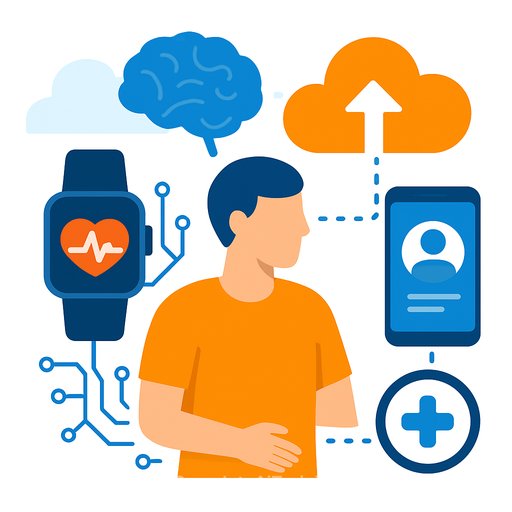AI, Wearables, and Emerging Tech Are Transforming Healthcare: What Leaders Should Do Next
Digital health ecosystems driven by the IoMT, mobile apps, and smart medical devices are moving care from reactive to proactive. Early detection, behavioural nudging, and real-time alerts are now within reach-if systems are ready for them.
AI as the clinical engine
Artificial intelligence is becoming the backbone of diagnostics and operations. The market is set to grow at a 38.5% CAGR (2024-2030), reaching $188B+. Hospitals already use machine learning for earlier detection of cancer and sepsis, with improving accuracy.
Adoption is broad: 79% of healthcare organisations are using AI and report an average 3.2× ROI within 14 months (Microsoft & IDC). Ethical guardrails still matter-data bias, algorithmic transparency, and clinical validation. By 2050, AI will be an indispensable assistant, accelerating decisions rather than replacing them.
- Start with high-yield use cases: sepsis early warning, imaging triage, denials management.
- Stand up an AI governance board with clinical, data, legal, and patient representation.
- Require prospective validation, bias audits across subpopulations, and drift monitoring.
- Track impact metrics (time-to-diagnosis, false alarms, LOS, readmissions) from day one.
Cloud and Big Data at clinical scale
Healthcare data is projected to hit 10,800 exabytes by 2025. Cloud platforms make it feasible to store, share, and analyse this volume securely. Predictive analytics from Big Data have reduced hospital readmissions by up to 40%.
Security and privacy remain non-negotiable. Adopt architectures and processes that meet HIPAA and GDPR standards to maintain trust, especially as cyberattacks on health systems increase.
- Use zero-trust controls, encryption in transit/at rest, and hardware-backed key management.
- Map data flows and PHI access; enforce least privilege and continuous auditing.
- Adopt open standards (FHIR, HL7, DICOM) and event-driven pipelines for interoperability.
- Define retention, deletion, and de-identification policies upfront.
Big Tech's role: value and vigilance
Amazon's PillPack and One Medical deals signal a hybrid care model. Apple Watch brought ECG and fall detection to millions. Microsoft and Google are deeply embedded in health data and cloud services. The upside is speed; the risk is control.
Key questions: Who owns the data? How portable is it? Can patients trust non-health companies with sensitive information? Regulation and transparency will decide whether partnerships enhance health systems-or dominate them.
- Contract for data ownership, portability, deletion rights, and model explainability.
- Insist on independent security and privacy audits; publish summaries internally.
- Avoid lock-in: prefer open APIs, export tooling, and explicit exit plans.
Wearables and remote monitoring
Telehealth momentum continues. In the United States, 60%+ of telehealth patients share data from wearables. Glucose monitors, smartwatches, and connected cuffs support chronic care, post-op recovery, and prevention.
Clinician concerns are valid: data overload, device accuracy, and workflow fit. The digital divide is real. Solve for usability on both sides of the screen.
- Set clear thresholds, escalation paths, and staffing for alerts to reduce alarm fatigue.
- Prefer devices with regulatory clearance where applicable and published accuracy.
- Integrate into EHR workflows (in-basket, orders, documentation) via FHIR Subscriptions.
- Offer connectivity support, loaner devices, and multilingual education for patients.
Connected ecosystems with the IoMT
Seamless data exchange across patients, providers, devices, and systems unlocks early detection, nudges, and real-time interventions. Legacy and proprietary systems still block collaboration.
- Inventory devices and map data to standards: FHIR R4, HL7 v2, DICOM, IEEE 11073.
- Use API gateways and secure device networks with microsegmentation.
- Adopt a cybersecurity framework and run incident response drills with clinical teams.
- Budget for inclusive infrastructure: rural connectivity, patient access, and staff training.
What to execute this quarter
- Pick two AI pilots with clear ROI and safety metrics (e.g., sepsis alerting, imaging triage).
- Form a cross-functional AI and data governance council.
- Migrate one high-value analytics workload to the cloud with end-to-end security controls.
- Launch a remote patient monitoring program for one condition with defined KPIs and staffing.
- Create a due diligence checklist for Big Tech vendors focused on data rights and portability.
- Upskill clinicians, data teams, and IT on AI, privacy, and workflow integration. See AI courses by job.
Notable facts
- 38.5% CAGR for AI in healthcare (2024-2030), reaching $188B+.
- 79% of healthcare organisations are adopting AI; average 3.2× ROI within 14 months (Microsoft & IDC, 2024).
- Predictive analytics from Big Data has reduced readmissions by up to 40%.
- Global healthcare data volume expected to reach 10,800 exabytes by 2025.
Healthcare is moving toward care that is predictive, personalised, and continuous. To make it real at scale, leaders must pair bold innovation with responsible governance, strong data protection, and equitable deployment-always anchored in clinical outcomes and trust.
References available on request.
Your membership also unlocks:






